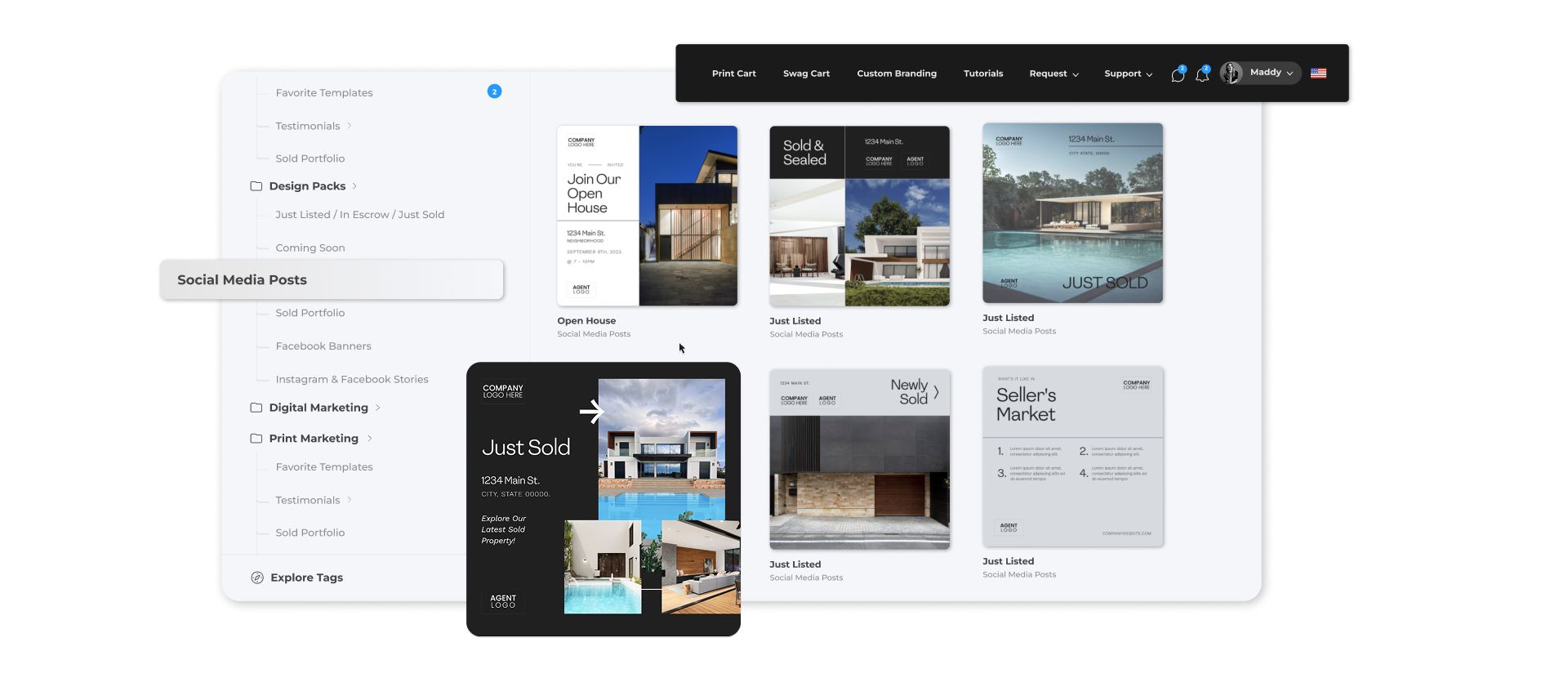Real estate marketing isn’t broken, but for many brokerages, it’s painfully inefficient. Marketing teams spend countless hours fixing off-brand flyers, managing last-minute design requests, and juggling tools that don’t talk to each other. The result? Inconsistent branding, wasted time, and frustrated agents.
The good news is, there’s a smarter way. In 2025, the right real estate marketing system can give you brand control, automation, and AI-powered efficiency, all while empowering agents to create polished, compliant materials in minutes.
This article breaks down the non-negotiable features your marketing tech stack needs to scale, protect your brand, and stay competitive. They work whether you’re a boutique firm or a 10,000-agent powerhouse.
Brand Control at Scale

When a brokerage grows, so does the risk of brand dilution. With dozens or even thousands of agents creating their own flyers, postcards, and social posts, it’s easy for off-brand colors, mismatched fonts, or missing disclaimers to slip through. Over time, that inconsistency weakens trust in your brokerage's identity and creates extra work for marketing and administrative staff who have to “fix” what agents submit.
A well-built real estate marketing system solves this by giving your team control without bottlenecks. The key is to lock in the elements that define your brand, like logos, fonts, disclaimers, and headshots, while still allowing agents to personalize the content they need for their listings.
Another important aspect to consider is admin-level permissions and version control. These features let marketing leaders set the rules, approve changes, and roll out updates instantly across the entire organization. Pair that with a centralized asset library, and everyone has access to the most current, compliant real estate marketing materials.
What to look for:
- Locked templates with flexible agent inputs
- Admin-level permissions and version control
- Centralized asset library for fonts, logos, disclaimers, and headshots
Maxa Designs was built with this balance in mind. Agents can customize marketing templates to highlight their listings, while marketing teams stay confident that no one is straying from the brand playbook. The result is faster marketing, fewer headaches, and a brokerage that looks polished and professional at every touch point.
Design Automation & Template Libraries
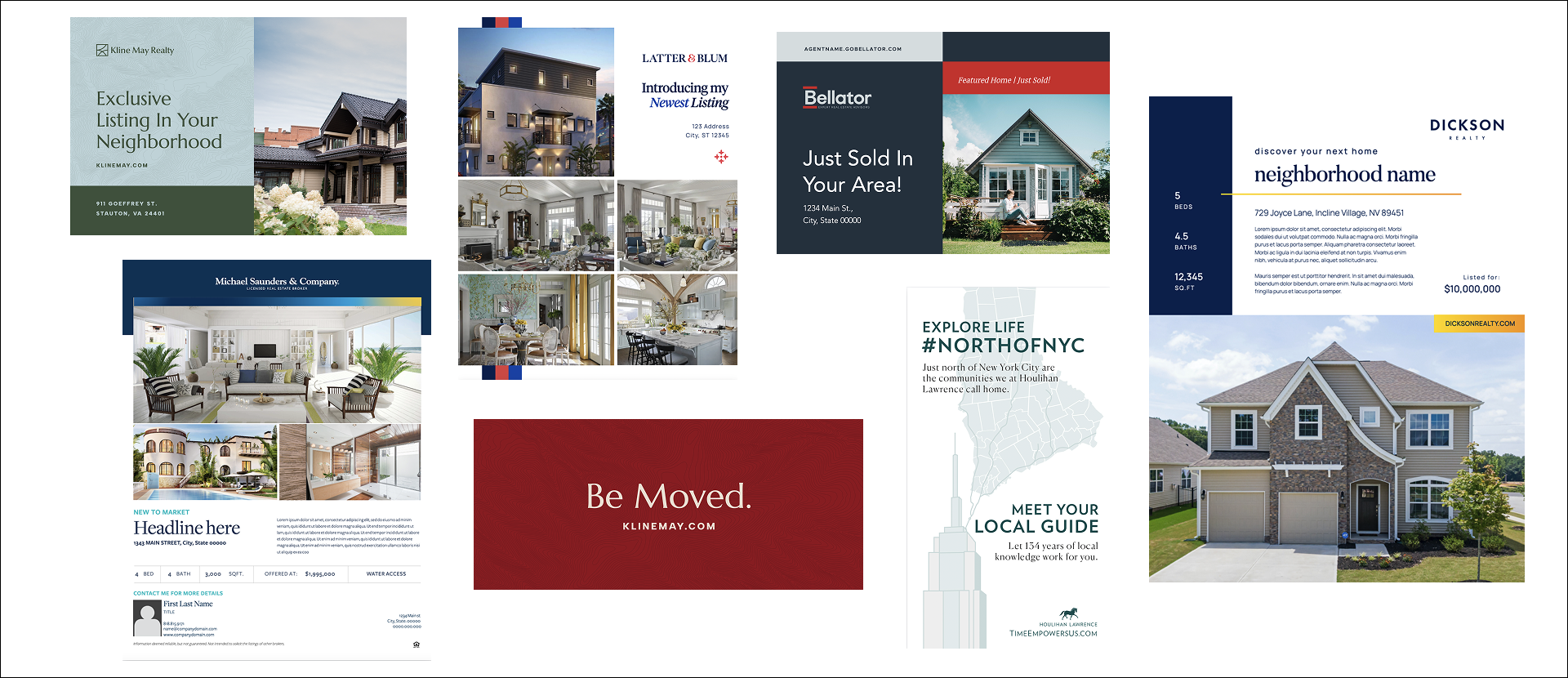
Speed matters in real estate, as a property can hit the market in the morning and already have multiple showings by afternoon. If your marketing system can't keep pace, this can lead to lost opportunities. That's why design automation and template libraries are non-negotiables today.
Instead of waiting on a designer for every flyer or social post, agents and admins should be able to pull from a library of prebuilt, on-brand templates, such as:
- Listing presentations
- Property flyers
- Postcards
- Brochures
- Social media graphics
But the real advantage comes from automation. With MLS integration, property details, photos, and even pricing can auto-populate in the templates, eliminating repetitive manual work and cutting turnaround time to near zero. Add in one-click formatting, and that same flyer can instantly be resized for Instagram, turned into an e-mail header, or exported as a print-ready PDF.
This kind of efficiency doesn't just save time but reduces errors, keeps branding consistent, and ensures you’re always ready when the market moves fast.
What to look for:
- Pre-built templates for flyers, brochures, postcards, and listing presentations
- Auto-populated data (e.g., MLS integration)
- One-click formatting for social, email, and print
Multi-Channel Publishing Capabilities
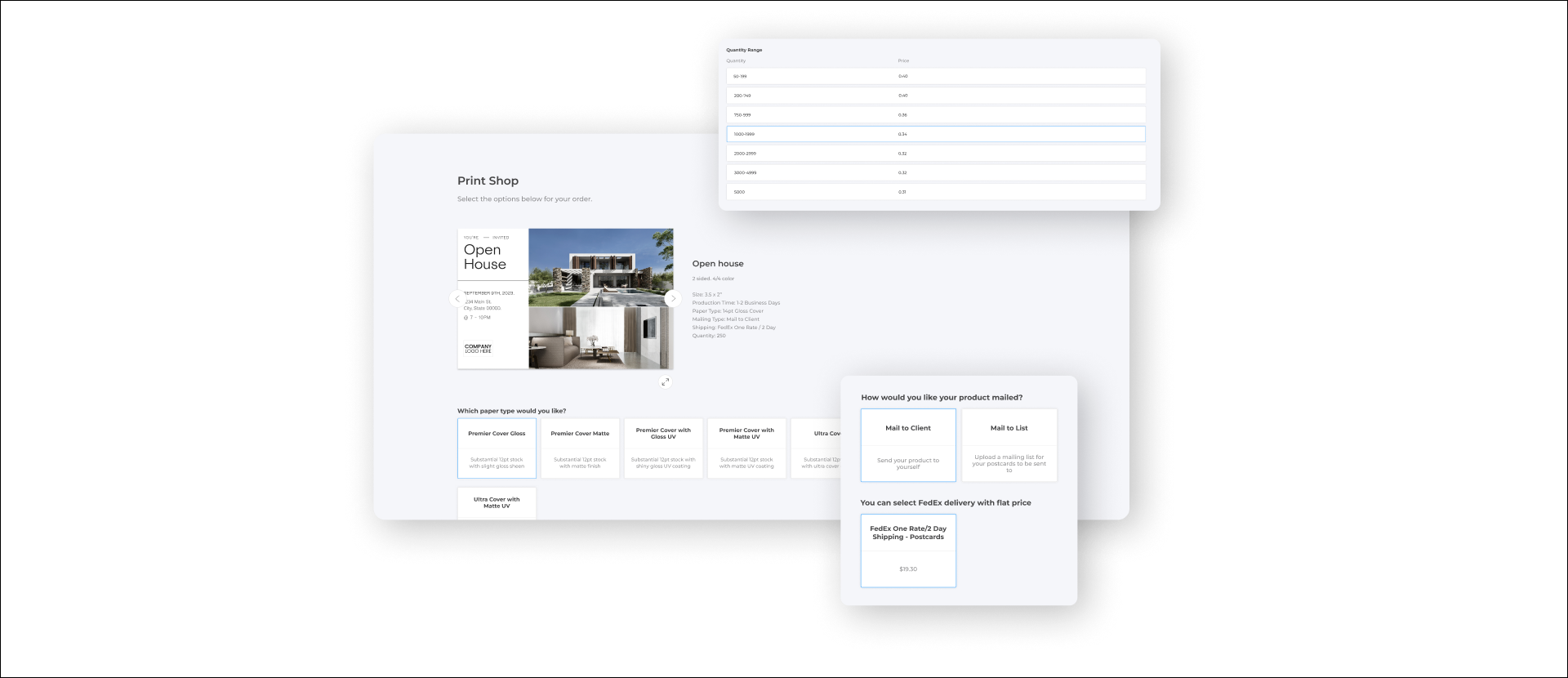
Modern brokerages need a real estate marketing system that can take one design and push it across every channel where buyers and sellers spend their time. This is because real estate marketing no longer lives in one place.
That means your platform should do more than just export files. It should offer direct publishing to the channels your agents use every day, including Instagram, Facebook, and email tools for print. For example, it should generate print-ready PDFs or connect directly to trusted print vendors, so you're not wasting hours fixing file formats.
You should also incorporate video and GIF export options, as these formats are becoming more appealing to the younger population. Motion grabs attention on social feeds, and short animated property teasers can help your listings stand out. The easier it is to repurpose a single design into multiple formats, the faster your team can get content live and the more consistent your brand will appear across all platforms.
What to look for:
- Direct publishing to Instagram, Facebook, and email tools
- Print-ready PDFs and integration with print vendors
- Video and GIF export options for listings
Agent Empowerment Without Design Skills
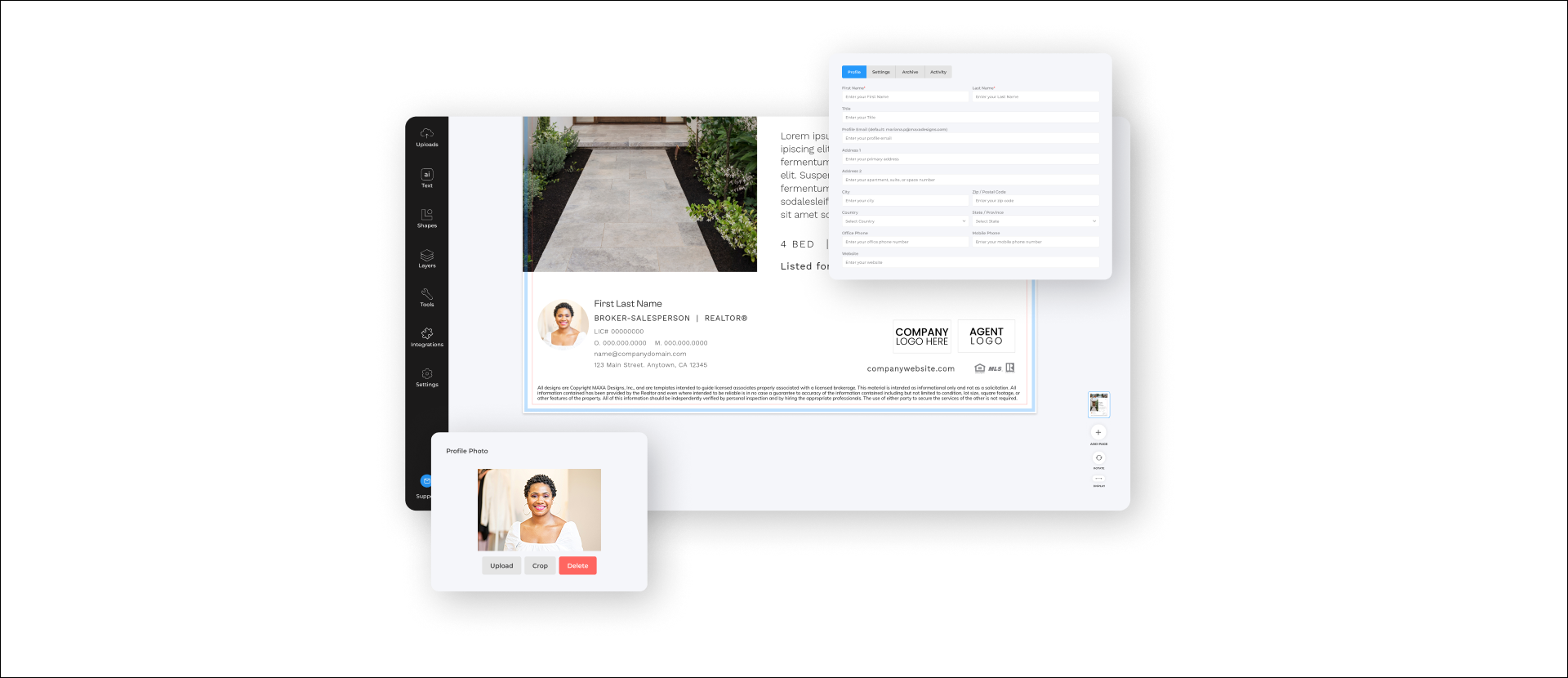
Not every agent is a marketer or a designer, and they shouldn't have to be. Listing a property or sending out a postcard shouldn't take serious Photoshop skills, as this can lead to bottlenecks and cause marketing staff to spend more time fixing designs than running campaigns. A real estate marketing system should make it possible for agents to build what they need without leaning on the creative team at every turn.
For example, an intuitive drag-and-drop interface would allow agents to simply drop a photo into a flyer template, without wasting too much time. You could also create tutorials and build a searchable help center, which would eliminate the need for constant back-and-forths with the design team.
Ideally, this system should also be connected to your customer relationship management (CRM) platform or set up with single sign-on (SSO), so your agents wouldn’t need to juggle multiple logins.
What to look for:
- Intuitive drag-and-drop interface
- Built-in tutorials or help center
- CRM or SSO integrations for seamless login
The outcome is that agents create more marketing content with fewer bottlenecks, so your marketing team can focus on building and following a marketing plan instead of doing tech support.
Reporting, Insights & Compliance

When you don't have visibility into how your marketing tools are being used, it's almost impossible to know what's working and what isn't. Usage data and campaign insights are essential for spotting strengths, identifying weak points, and making sure your investment in a real estate marketing system is actually paying off.
The most effective platforms provide detailed reporting that shows who is creating materials, which templates are being used most often, and how these assets perform once they're shared. Instead of relying on assumptions, you can track downloads, print volume, and even social engagement directly from the system, allowing you to make data-backed adjustments in real time.
Another piece that can’t be overlooked is compliance. Legal disclaimers, license numbers, and brokerage information need to appear consistently across every design. Relying on agents to add them manually is a recipe for mistakes. By embedding compliance fields directly into templates, brokerages protect themselves while making it easier for agents to focus on sales instead of fine print.
What to look for:
- Usage tracking (who’s using the platform and how)
- Print/download/social analytics
- Built-in compliance fields (e.g., legal disclaimers and license numbers)
Scalable, Secure, and Customizable Infrastructure
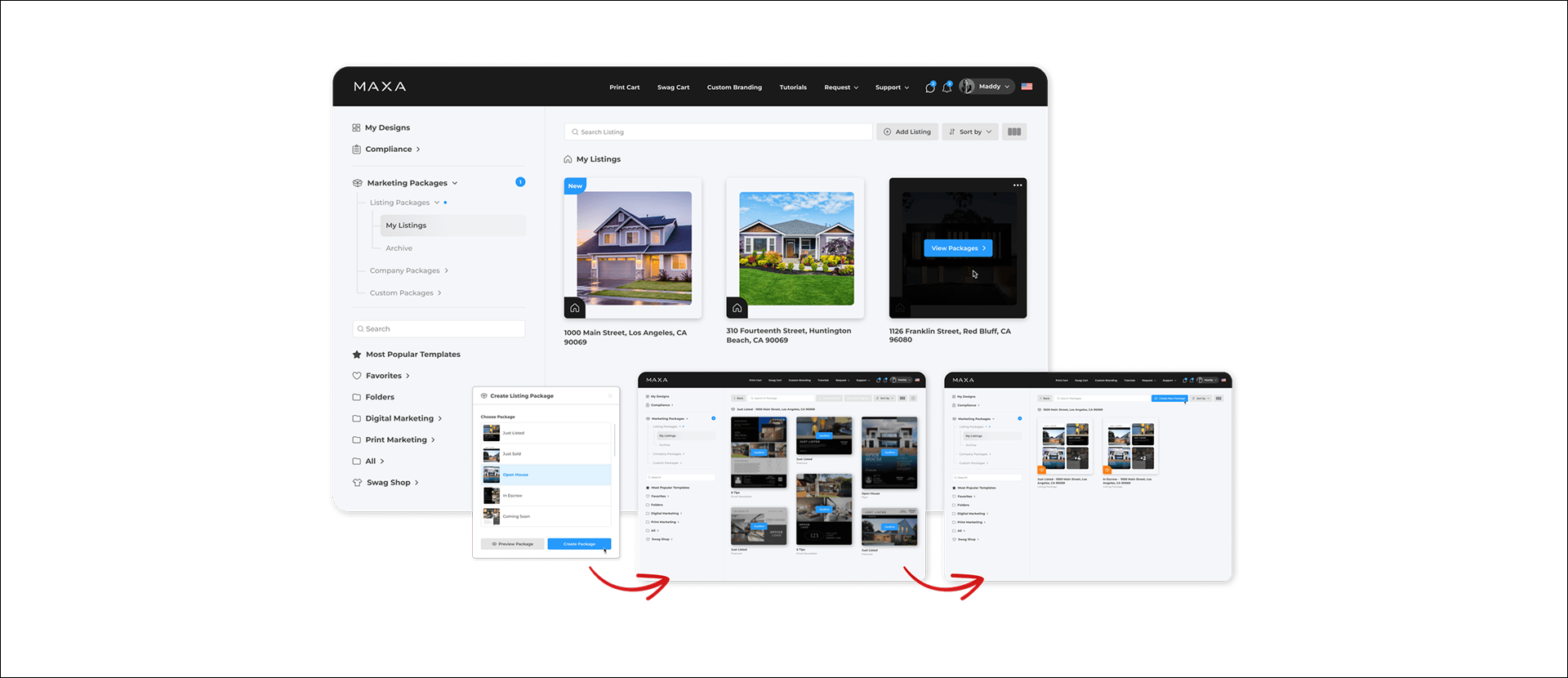
As your business expands, the systems that once felt sufficient often begin to break down. For instance, a platform that comfortably supports a small office may struggle the moment multiple branches, hundreds of agents, or thousands of marketing assets are added into the mix.
Scalability also requires multi-office support so each branch has access to the right tools while leadership maintains control over the brand at large. It also means offering white-label capabilities, giving brokerages the ability to present the platform as their own rather than piecing together a collection of generic tools.
Marketing systems also store sensitive client information, brand assets, and design templates that represent years of investment. That's why security is of great importance. Without enterprise-grade security and responsive support, you may expose your platform to unnecessary risk. Encryption, access control, and reliable uptime are no longer optional but a part of the standard every system should deliver.
What to look for:
- Multi-office support
- White-label capabilities
- Enterprise-grade security and support
AI and Smart Personalization (Bonus for 2025)
.png)
Artificial intelligence is no longer a novelty in real estate marketing. It's quickly becoming the differentiator between brokerages that keep up and those that fall behind. By weaving AI into everyday workflows, you can cut down repetitive tasks, reduce bottlenecks, generate leads, and deliver campaigns that feel far more personalized to clients and prospects.
For content creation, AI-powered text suggestions can help you generate listing descriptions, social headlines, and even email subject lines in seconds. This saves time for agents while helping marketing staff maintain consistency in tone and messaging. Beyond copywriting, AI is also changing how templates adapt. For example, imagine a system that recognizes an agent's persona, their market, or the type of property they're listing, and automatically surfaces the most effective layouts and formats.
With the right data, a real estate marketing system can also suggest which template works best for a luxury condo versus a starter home, or which format drives stronger engagement for social media versus printed formats. This level of personalization used to take hours of manual testing and guesswork, but today AI makes it available instantly.
What to look for:
- AI-powered text suggestions (e.g., for property descriptions and headlines)
- Dynamic templates based on agent persona or market
- Smart recommendations based on listing type
Conclusion: Choosing the Right Platform in 2025
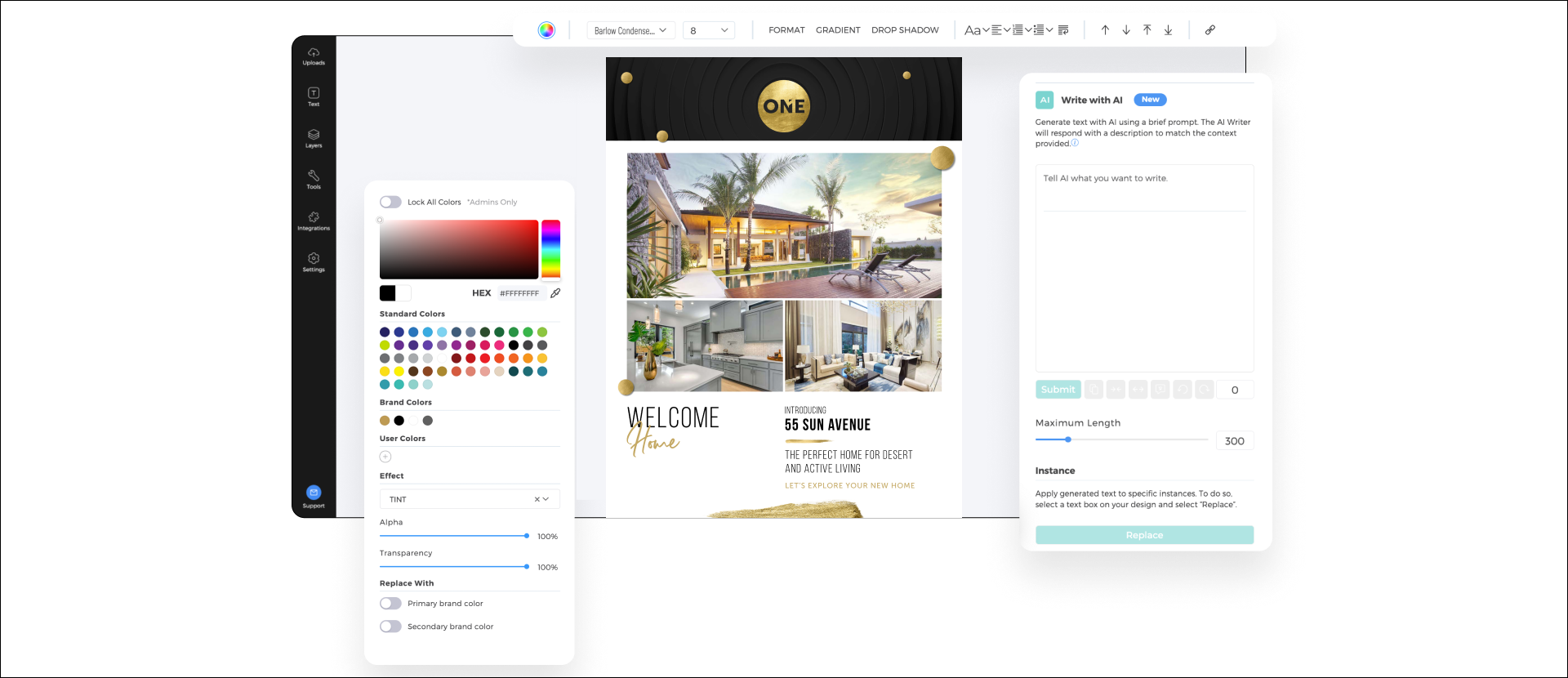
Brokerages can no longer rely on ad hoc tools or manual fixes when brand consistency, speed, and compliance are at stake. A modern real estate marketing system needs to bring together brand control, design automation, multi-channel publishing, agent empowerment, reporting, scalability, and now AI-driven personalization.
When these capabilities work as one, you’ll spend less time troubleshooting and more time driving growth, while your agents gain the freedom to produce polished materials without delays. The firms that embrace these systems will move faster, scale smarter, and stand out in a crowded market.
If your brokerage wants faster campaigns, consistent branding, and agents who can market without roadblocks, MAXA delivers the right tools to achieve this. Schedule a demo today to see how we can transform your marketing.


